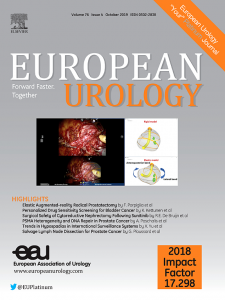Stereotactic Intensity-modulated Radiotherapy After Radical Prostatectomy (SCIMITAR): 4-Year Outcomes of a Phase 2 Clinical Trial
IF 25.2
1区 医学
Q1 UROLOGY & NEPHROLOGY
引用次数: 0
Abstract
In the phase 2 SCIMITAR trial, stereotactic body radiotherapy (SBRT; 30–34 Gy in 5 fractions) was delivered to the prostatic fossa after radical prostatectomy in 100 patients requiring postoperative RT, with or without nodal RT and androgen deprivation therapy (ADT). The primary endpoint was 4-yr biochemical recurrence (BCR)-free survival (BCR-FS), with events defined as BCR (prostate-specific antigen ≥0.2 ng/ml above nadir), salvage ADT, or death. Outcomes were compared to individual patient data (IPD) from a phase 3 trial of conventionally fractionated RT (CFRT) using inverse probability of treatment weighting and Fine-Gray models. At median follow-up of 53 mo, the 4-yr BCR-FS rate was 60% (95% confidence interval [CI] 50–70%). The IPD analysis revealed that for men not receiving ADT, the risk of BCR was lower with SBRT than with CFRT (subdistribution hazard ratio [sHR] 0.49, 95% CI 0.29–0.84; p = 0.008). For men receiving ADT, there was no significant difference in BCR risk between SBRT and CFRT (sHR 1.58, 95% CI 0.81–3.11; p = 0.18), although the asymmetrically broad 95%CI and directionality of the point estimate suggest that a higher BCR risk with SBRT cannot be ruled out. The 4-yr cumulative incidence rates for late grade ≥2 gastrointestinal and genitourinary toxicities were 6.6% and 32%, respectively. At 48 mo, the proportion of patients reporting a decline of more than two times the minimal clinically important difference in urinary incontinence, urinary irritative/obstructive, bowel, and sexual domains was 23%, 6.7%, 13%, and 9.7%, respectively. SBRT to the prostatic fossa appears to be safe and effective through 4 yr.根治性前列腺切除术后立体定向调强放疗(cimitar):一项2期临床试验的4年结果
在2期cimitar试验中,对100例需要术后放疗的根治性前列腺切除术患者进行立体定向体放疗(SBRT; 30-34 Gy分5次),伴或不伴淋巴结放疗和雄激素剥夺治疗(ADT)。主要终点是4年无生化复发(BCR)生存期(BCR- fs),事件定义为BCR(前列腺特异性抗原≥0.2 ng/ml)、补救性ADT或死亡。使用治疗加权逆概率和Fine-Gray模型,将结果与常规分级放疗(CFRT)的3期试验的个体患者数据(IPD)进行比较。在中位随访53个月时,4年BCR-FS率为60%(95%可信区间[CI] 50-70%)。IPD分析显示,对于未接受ADT的男性,SBRT的BCR风险低于CFRT(亚分布风险比[sHR] 0.49, 95% CI 0.29-0.84; p = 0.008)。对于接受ADT的男性,SBRT和CFRT之间的BCR风险没有显著差异(sHR 1.58, 95%CI 0.81-3.11; p = 0.18),尽管不对称的95%CI和点估计的方向性表明不能排除SBRT有更高的BCR风险。≥2级晚期胃肠道和泌尿生殖系统毒性的4年累积发生率分别为6.6%和32%。在48个月时,报告尿失禁、尿刺激/梗阻性、肠道和性领域最小临床重要差异下降两倍以上的患者比例分别为23%、6.7%、13%和9.7%。前列腺窝的SBRT在4年内是安全有效的。
本文章由计算机程序翻译,如有差异,请以英文原文为准。
求助全文
约1分钟内获得全文
求助全文
来源期刊

European urology
医学-泌尿学与肾脏学
CiteScore
43.00
自引率
2.60%
发文量
1753
审稿时长
23 days
期刊介绍:
European Urology is a peer-reviewed journal that publishes original articles and reviews on a broad spectrum of urological issues. Covering topics such as oncology, impotence, infertility, pediatrics, lithiasis and endourology, the journal also highlights recent advances in techniques, instrumentation, surgery, and pediatric urology. This comprehensive approach provides readers with an in-depth guide to international developments in urology.
 求助内容:
求助内容: 应助结果提醒方式:
应助结果提醒方式:


